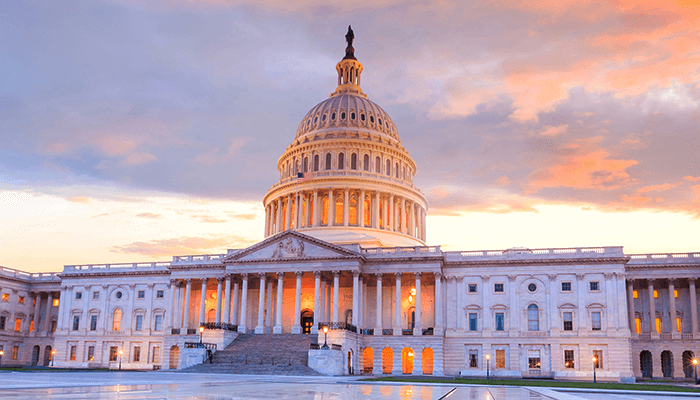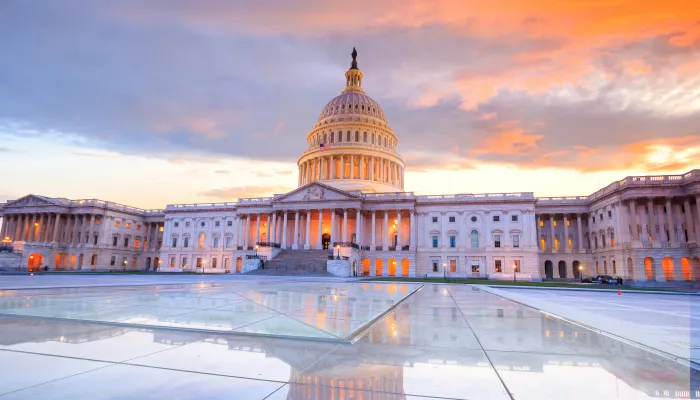President Trump's FY 2018 "Skinny Budget"
The Trump Administration today released its "skinny budget," which details its plans for defense and non-defense discretionary spending for Fiscal Year (FY) 2018 while proposing some adjustments for the current fiscal year. However, unlike prior skinny budgets from first-year presidents, President Trump’s budget does not include any proposed changes to mandatory spending or revenue, nor proposals and cost estimates in the years beyond 2018. By focusing only on discretionary spending, this budget effectively ignores 70 percent of spending and 90 percent of its growth over the next decade.
For FY 2018, the budget calls for a $54 billion increase in defense spending – a full repeal of the cap reductions often referred to as “sequester.” To offset these costs, the budget reduces non-defense discretionary spending by about one-tenth. Relative to today’s level, the budget would cut the State Department by 29 percent ($11 billion), the Environmental Protection Agency by 31 percent ($3 billion), the Health and Human Services Department by 16 percent ($13 billion), and the Education Department by 14 percent ($9 billion). Most other domestic agencies would also see substantial cuts; 19 smaller agencies would be eliminated entirely. The Veterans Affairs and Homeland Security Departments would see their funding boosted a combined $7 billion – by 6 and 7 percent, respectively.
The Trump Administration deserves credit for proposing to fully pay for its proposed FY 2018 defense hikes with specific offsets. It is unfortunate that the budget fails to apply this principle to proposed supplemental spending for this year.
We are also disappointed that the budget does not include a multi-year plan to enact and pay for the President’s agenda and address our rising debt. While a president’s first budget is often “skinny,” past presidents’ first budgets (including skinny ones) have included significant mandatory and revenue proposals along with a 5- or 10-year projection of how those proposals will affect the nation’s bottom line.
We are heartened by Office of Management and Budget (OMB) Director Mick Mulvaney’s nod to meeting “another of the President’s core commitments: addressing our Nation’s priorities without sending future generations an even bigger credit card bill. This 2018 Budget Blueprint will not add to the deficit.” Unfortunately, the proposed supplemental spending for FY 2017 does add to the deficit. However, we hope the full budget will meet that minimum standard.
Still, the OMB Director also notes “Our $20 trillion national debt is a crisis, not just for the Nation, but for every citizen.” Given our near-record debt levels, and our unsustainable debt trajectory, we encourage President Trump to follow up promptly with a more comprehensive budget that makes clear how his agenda fits together and what it would mean for spending, revenue, deficits, and the national debt. That budget should put the debt on a clear downward path relative to the economy.
FY 2018 Defense Hikes Are Paid For With Non-Defense Cuts
In FY 2018, spending levels set by the Bipartisan Budget Act will expire, and the “sequester” on discretionary spending will fully return. As a result, overall caps on non-exempt discretionary spending will be set at $1.065 trillion, compared to $1.070 trillion in FY 2017 and $1.156 trillion in FY 2018 if the sequester were eliminated.
President Trump’s budget would reverse the sequester on defense, increasing the FY 2018 cap from $549 billion ($551 billion in FY 2017) to $603 billion. To pay for this increase, President Trump would keep the overall cap at sequester levels – $1.065 trillion – and thus reduce non-defense spending by $54 billion, from $516 billion ($519 billion in FY 2017) to $462 billion.
Relative to FY 2017, these changes represent a 9 percent increase in defense spending and an 11 percent reduction in non-defense spending. Relative to current law sequester caps for 2018, they represent a 10 percent defense increase and a 10 percent non-defense cut.
Non-Defense Reductions Would Affect Most Agencies
The $54 billion of cuts to non-defense discretionary spending – $57 billion relative to FY 2017 spending levels – comes from a wide variety of sources. Many of them are areas the Administration argues are ineffective, duplicative, wasteful, or better performed outside the federal government.
More than half of the proposed cuts in the budget come from three agencies – the Departments of State, Health and Human Services (HHS), and Education.
Of these three, the State Department would face the largest percentage cut – 29 percent, or $11 billion. Much of these cuts would come from reductions in foreign aid; the budget specifically proposes cuts in funding for United Nations peacekeeping missions and to the Food for Peace program, which sends food to conflict-ridden areas.
HHS spending would be cut by 16 percent from current levels, or nearly $13 billion. About half of these cuts come from reducing discretionary funding given to the National Institutes of Health. Other large cuts come from ending the Low Income Home Energy Assistance Program and the Community Services Block Grants.
The Education Department would face a $9 billion (13.5 percent) cut, despite $1.4 billion of new spending on school choice initiatives to encourage charter schools and pilot school voucher programs. Reductions in education spending would come mainly from eliminating certain secondary and post-secondary education grant programs, funding for afterschool and summer programs, and over 20 additional programs that the Administration deems unnecessary.
Other agencies would generate smaller savings for the budget but face large cuts relative to their current spending. The $2.6 billion cut to the Environmental Protection Agency, for example, represents a 32 percent reduction from current levels. This includes reductions to the Superfund (a $330 million, or 30 percent, cut), which funds the cleanup of sites with hazardous materials; grants to fund state activities that go beyond federal requirements; research; and enforcement. Funding would also be eliminated for regional initiatives such as the Chesapeake Bay and Great Lakes as well as for the Energy Star appliance program.
The budget also eliminates whole programs in many cases. Within the Housing and Urban Development Department, for example, the budget would save $3 billion by eliminating Community Development Block Grants. These grants provide communities with funds to aid low-income households, rehabilitate housing, improve infrastructure, or repay bonds issued by local governments.
Nineteen small agencies are defunded entirely, including the Corporation for Public Broadcasting, the National Endowment for the Arts, the National Endowment for the Humanities, the U.S. Trade and Development Agency, and several commissions, councils, and boards.
Two non-defense departments would see their funding increased under this budget. The Veterans Affairs Department would see a $4 billion (6 percent) boost in funding, particularly for veterans’ health care. The Homeland Security Department would also see a net $3 billion (7 percent) increase, with an increase in funding for the border wall and immigration enforcement and cybersecurity, partially offset by reductions in Transportation Security Administration screening programs and emergency preparedness grants.
Increases in FY 2017 Spending Are Only Partially Offset
In addition to the changes in FY 2018 discretionary spending, the budget also includes supplemental appropriations for FY 2017; however, unlike the FY 2018 changes, this funding is not fully offset. The budget includes $25 billion for defense spending, $5 billion for Overseas Contingency Operations, and $3 billion for the border wall and implementation of the immigration executive orders, offset by an $18 billion reduction in non-defense funding. Though the specifics of the spending increases are provided, the details on the non-defense cuts are not.
On net, these changes would increase FY 2017 discretionary spending by $15 billion and increase deficits by a similar amount. The supplemental appropriations should be offset with equivalent spending cuts, or they should be reduced to the amount of cuts the Administration is willing to make. Since these appropriations are not emergencies, there is no reason to avoid fully offsetting their cost.
Most of the Budget Remains Missing
Though other recent presidents’ first budgets may have been somewhat light on details relative to their future budgets, all have included a multi-year budget plan that included many parts of their agenda. President Trump’s skinny budget is distinctive in that it focuses on FY 2017 and FY 2018 discretionary spending alone.
This focus is concerning in part given the high potential cost of many of the proposals President Trump touted on the campaign and in recent months. It is also troubling in that the document ignores the largest and fastest-growing parts of the federal budget.
In FY 2018, all non-defense discretionary (NDD) spending – the only area President Trump has proposed to cut in this budget – will make up 15 percent of federal spending under current law. Social Security alone will consume a quarter of the budget and health spending another quarter. Other mandatory spending will make up one-eighth of the budget. These parts of the budget, along with interest, are responsible for 90 percent of spending growth over the next decade under current law; NDD spending is responsible for 4 percent.
In addition to excluding any changes to mandatory programs, the President’s budget also excludes any proposed revenue changes. Income tax expenditures alone will cost over $1.6 trillion in FY 2018, which is more than 2.5 times as large as NDD spending and if considered part of the budget would consume almost 30 percent of all spending.
The lack of mandatory spending and revenue proposals in this budget is particularly concerning given the nation’s post-WWII-era record-high and rapidly rising national debt. Left unchecked, this rising debt would seriously threaten economic growth and overall government functioning. By not having its own budget projection or an evaluation of policies that are likely to come up in the context of that projection, the Administration leaves both lawmakers and the public in the dark about the potential fiscal consequences of its policies.
Conclusion
The President’s FY 2018 skinny budget details the Trump Administration’s plans for appropriations in the upcoming fiscal year but little else. The budget would maintain the overall spending limits for FY 2018 but repeal the defense sequester while shifting all of those cuts to non-defense discretionary spending.
It is encouraging that President Trump proposes to pay for most new spending in this budget with detailed proposals to cut spending elsewhere. We are disappointed the budget does not apply this principle in full to proposed supplemental spending, and we hope going forward the President will be as insistent on offsets as he is on spending increases.
Unfortunately, the budget does not include any proposals on mandatory spending or revenue and does not include any proposals or projections beyond 2018. In this sense, this budget ignores the 70 percent of spending that is responsible for 90 percent of spending growth over the next decade and tells us nothing about how the Administration will address the nation’s unsustainably rising national debt.
The Administration can rectify this lack of detail by putting out more proposals in the coming weeks and releasing their fuller budget as quickly as possible. Until a budget plan is proposed and agreed to, legislative changes with major fiscal implications should be avoided.
The fiscal situation requires that Presidents' budgets set a course for putting debt on a sustainable path, and the Trump Administration should present policies to get us there.


